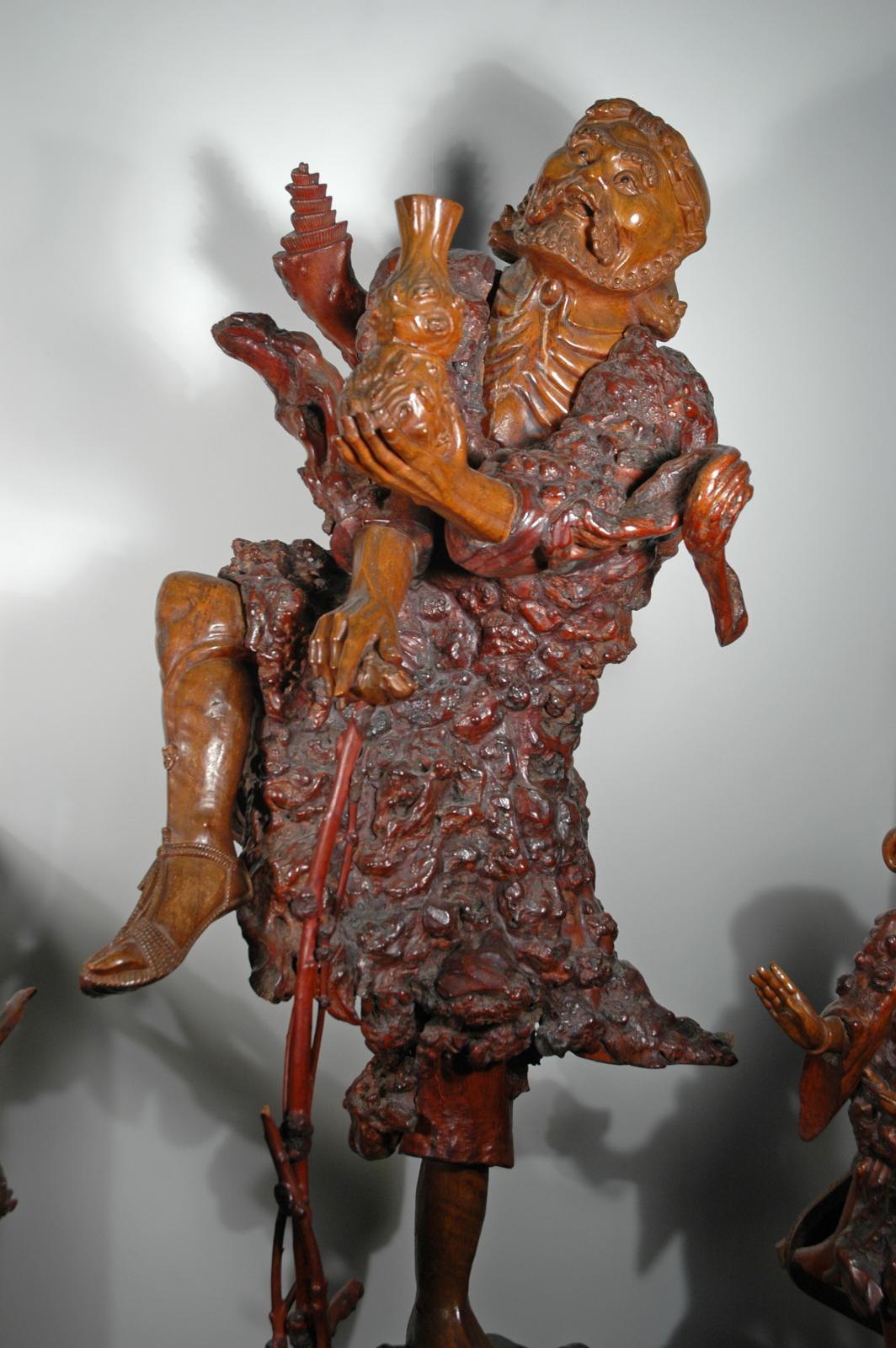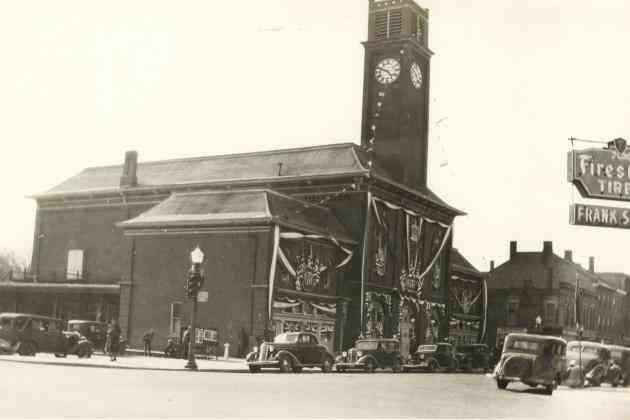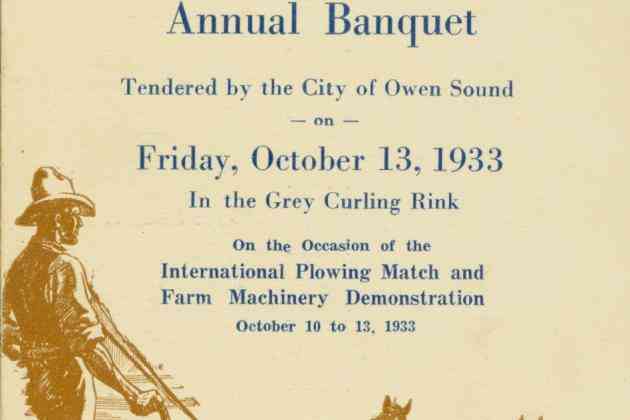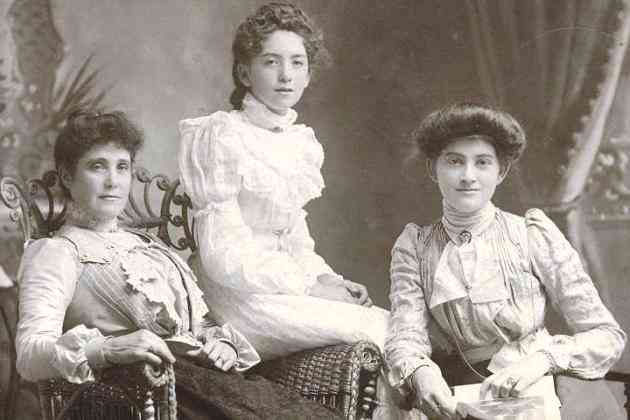An Immortal in Our Midst
Almost every day at Grey Roots, the Collections Department’s staff work near a large carved sculpture, that has become somewhat of a “friend” to me, over the years, and has intrigued many others as well. When I was a child, and visited the County of Grey-Owen Sound Museum, where it was then on long-term exhibition, I was thrilled by the “Ripley Believe it Or Not” style hand-lettered display card that John J. Landen, the previous Curator, had placed with the piece:
CHINESE WOOD SCULPTURE
TITLED—LI OF THE IRON CRUTCH. ONE OF THE LEGENDARY EIGHT TAOIST IMMORTALS
Presented to Dr. Edward H. Horsey, M.P., on his return to Canada from China. As a bad omen at the presentation, he was told that he would die of decapitation. Dr. Horsey, on his return to Canada, became a prominent politician, by defeating in an election, Mr. Charles Gordon, in the year 1900. In the year 1902, Dr. Horsey was asked to officiate at the opening of the Sun Cement Co. Plant.
Following the ceremony, he entered to see the plant in operation when a large fly-wheel disintegrated, a portion of it striking and decapitating Dr. Horsey. At the same time, demolishing one building as it burst into fragments. Dr. Horsey—born 1867—died at the age of 35 years in 1902…This, as was related to the Museum.”
When I began to work at the museum, I heard people say that the sculpture had a curse on it, and that the curse had been placed on whoever took the sculpture away from China. In the days before the Internet, there was no quick way to research an unusual item like this. There was a book at the Owen Sound Public Library, by Anthony Christie, called Chinese Mythology, 1968, that was useful to verify that the primary figure of the carving is indeed that of Li-Thieh-kuai, one of the eight Immortals of Taoism. He had magical powers, and the gourd that he carries in his hand contained medicines that could revive the dead. He had lost his mortal body while his soul was visiting the Master (Lao Tzu). His soul was reborn into the body of an emaciated, crippled beggar, who used a iron crutch, and had a bedroll carried on his back. Iron Crutch Li had eternal life, as a reward for acts he did on earth. The Li figure of the Grey Roots sculpture is flanked by two other figures. The one on the left is some sort of bird, and I have wondered if it might be a “Magic Bird”, that dances on one leg. The male attendant figure on the right side, is still a mystery to me as well. The woodcarver’s name is still not known, nor exactly how old the piece is. There is a hand-written small inscription that may allude to it having some sort of connection to a high official, but we still need an expert to verify what it means. The wood is expertly-carved, and there are unusual burl-like pieces and thick tree twigs employed as mounts for the three figures. A Chinese visitor who saw the piece earlier this year wondered if it might be made of rosewood. The bird component has received several chips / mars over the years, but overall, the carved trio are still in good condition.
Before the sculpture joined the museum collection, it had been shown or kept at the Owen Sound Public Library. Miss Ioleen Hawken, the Chief Librarian in 1959, decided to transfer it to the new museum project in Owen Sound. Prior to the library housing it, it apparently had been on long-term loan to the Simpson Department store in Toronto for exhibition (no dates provided for the file, of course), and then it had disappeared for a while, to be found in a Simpson’s storage area. It was returned to Owen Sound, to its owner’s home (again, no information in the file), where it served as a rack to hold hats and gloves, etc., not exactly a very dignified function for such an amazing a piece of art. It was on long-term exhibit at the County of Grey-Owen Sound Museum from the late 1960s up until c. 2000.
Now with internet information handy, another story of “Iron Crutch Li” is that he was benevolent to the poor, sick and needy and that he alleviated suffering with special medicine from his gourd (also called a calabash). Li also had once had a handsome body. One story is that one day when he was planning to undertake some spirit travel outside of his body, that he instructed an apprentice to guard his body, in which would remain his Po (corporeal soul), while his hun (ethereal soul) did its travelling. His apprentice was to guard his body for seven days, and if he didn’t return by then, the apprentice had permission to cremate the body. On the sixth day, the apprentice received word that his mother was sick, and as he wanted to rush home to care for her, he cremated Li’s beautiful body a day earlier than he was instructed to. When Li (in his hun) returned, he found that he had to inhabit another body, so he assumed the body of a recently-deceased beggar, a man who had been a cripple and had died of starvation.
There is also more information available about Dr. Horsey, who had owned the Chinese sculpture. Edward Henry Horsey was born at Ottawa on March 7, 1867, and became a medical graduate of Queen’s University. Being a physician in Ontario at that time was likely not a well-paying career, and without antibiotics and other advances in medicine that we now take for granted, it probably was not a job where one would have a lot of successful outcomes. Perhaps his imagination was sparked by the lure of travel, or adventure? In 1890, he married Leila A. MacDonald at Wingham, Ontario. The Horseys were listed in the 1891 census of Owen Sound, and his occupation was noted as “Phys. Allop.” (an allopathic Physician), and soon after, the couple travelled to the east. Dr. Horsey became an executive with the Sun Life insurance company, and was their manager in Asia. Mrs. Horsey accompanied him when he moved to Japan. They also lived in China for some time, and travelled widely. In November, 1897, Dr. Horsey was a Private Secretary as well to Li Hung Chang, of China. The Horseys returned to Canada.
Dr. Horsey, a Liberal, won the local riding in the 1900 election. He and his wife and two daughters were listed in the 1901 Census of Owen Sound. Interestingly, the household had two male servants at that time. One was a Japanese man named Kanga Lekematsu (b. Sept. 8, 1852, was 48 yrs. of age in 1901, Buddist, servant) and the other was a Japanese man named Hamano Lesugaro (b. Oct. 11, 1852, Buddist, Cook).
Before his death, one of the things that Dr. Horsey accomplished as a Member of Parliament was the introduction of Victoria Day as a May holiday. There had been discussion of a November holiday to honour the current King, but Horsey helped get the holiday placed in May, where it would be more convenient for Canadians to go on excursions, picnics, and so on.
He also was the founder and chief shareholder of the Sun Portland Cement Company at Owen Sound. His obituary mentioned how on July 23, 1902, he was escorting a group of men inside a building at the Sun Cement Plant, when a flywheel disintegrated, causing a lot of destruction. The others of the group were miraculously unharmed, but Dr. Horsey was mortally injured, as a piece of flying metal had hit his head. His death record, by Dr. Christopher McLean Lang, stated the cause of his death as being a “fracture of the skull and laceration of the brain”, not technically decapitation, but close enough… Dr. Horsey was buried at Greenwood Cemetery in Owen Sound. After his death in 1902, his widow and three daughters resided in England. Mrs. Horsey returned to Owen Sound on a couple of occasions to visit friends in town. She died in London, England in 1957.







